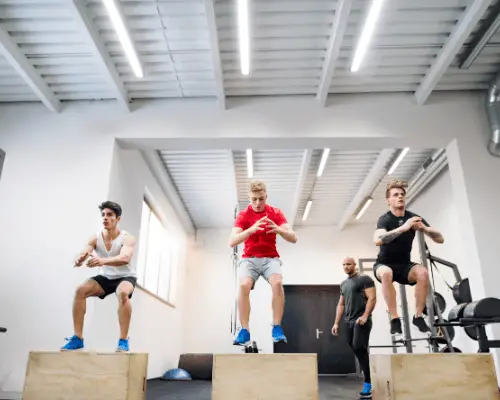Successfully running a marathon is all about preparation.
A solid training program, diet, and mindset will be the deciding factors in your ability to smash through that finish line with confidence.
Although preparing for a marathon is simple in theory, it takes a tremendous effort to pull off in real life. Preparing for, and eventually running one, will push your physical and mental capabilities to their apex.
Why is Endurance Important For A Marathon Runner?
Endurance training is good for the whole body.
Not only does it improve your cardiovascular health, but it also promotes positive mental health due to the endorphins that are associated with strenuous exercise.
A solid endurance system allows you to exert yourself for long periods of time before fatigue and muscular failure kicks in.
This is vital for marathon runners because they need to be able to keep a steady pace for extremely long periods of time.
Endurance is perhaps the most valuable skill and attributes to possess in the world of marathon running. It’s the area of training you need to focus on the most if you wish to complete your first marathon.
How do I Increase my Endurance for a Marathon Race?
Building world-class endurance doesn’t happen overnight.
It’s a long, painstaking process that will require some time and effort. However, the results will be well worth it if you stick with it.
By committing to a training plan that emphasizes progressive overload and adhering to a diet plan you’ll begin to see results in no time.
Slow and Steady Wins the Marathon Race
If you’re brand new to marathon training you’ll need to ease yourself into the process gradually.
Try not to overwhelm yourself too soon as this will ruin your confidence and increase the risk of injury.
Start with small steps. Challenge yourself to run around the block within a certain time period and then add a little more distance from there.
Soon you’ll be able to run a mile. You can then add another mile to your training from there.
This will do wonders for your confidence and will inspire you to push yourself further in the future.
It will also greatly reduce the risk of sustaining an injury.
If you’re brand new to running and want a quick jumpstart, check out this free printable training plan (no sign-up required):
How to Run 1 Mile When You’re Out of Shape
Your endurance needs to be gradually built up over a period of time. Enjoy the process, and don’t overload yourself with too much work too soon.
Yasso 800s
A popular choice for aspiring marathon runners, Yasso 800s are a terrific way to build speed and endurance.
Once you’ve decided your marathon goal time, convert it from hours and minutes to minutes and seconds.
Goal Marathon Finish Time
3 hours 20 minutes
Yasso 800 Time (2 times around the track)
3 minutes 20 seconds
For example, if you wish to complete a marathon in three hours and twenty minutes, your Yasso 800 time would be three minutes and twenty seconds.
From there, set yourself a target of running 800 meters in your converted goal time.
Rest for the same amount of time and then repeat the process.
Doing three to five repetitions once a week will seriously build your endurance. Just try not to overdo it by practicing several times a week.
You must be realistic when you’re running the Yasso 800 Time. Depending on your current fitness level and new goal marathon finish time, you will have to build up to your Yasso 800 Time. This may take the entire length of a full marathon training cycle (14-20 weeks).
By checking your progress and slowly building up to your Yasso 800 time, you will reduce the risk of injury. From the example above you may need to start at 3 minutes 40 seconds for a Yasso 800. You’ll need to listen to your body and adjust accordingly.
If you’re not progressing along as planned your goal may be too far out in front of you. In this case, you need to readjust your goal marathon finish time.
Benefits of Running Long and Slow
It’s vital to recreating the marathon environment as you’re training.
A long, slow run emulates the marathon environment well and also gets your body adjusted to proper running form.
Long runs also strengthen your muscles, tendons, and ligaments in preparation for the real thing.
One thing to keep in mind when running long distances is the impact it’ll have on your joints. Be sure to wear appropriate footwear and ensure that the terrain you are on is suitable.
Running long and slow also builds up your cardiovascular system – which is the secret ingredient of marathon success.
Benefits of Running Long and Fast
You can train hard or you can train long but you can’t do both.
You can, however, practice running long distances at an increased speed to really push your limits.
Long runs with short, sharp bursts of pace (strides) will help build up the muscles in your legs and give them that extra advantage when they need it most.
There is, however, a risk that you’ll injure yourself by running too fast for too long. Hamstring tears and pulled groin muscles are common ailments for sprinters so it’s important that you have an acceptable level of fitness before trying sprints.
High-intensity interval training (HIIT) is a highly effective way to burn fat and is greatly beneficial to long-term heart health – just make sure you can handle it before attempting. For a detailed post on HIIT and the “orange effect” check out: How to boost your marathon race with Orangetheory.
Why It’s Important to Not Miss Workouts
Consistency is vital for any kind of training.
Missing a workout may seem tempting in the short-term but you risk completely derailing your progress if it becomes a regular occurrence.
You’ll fall behind on your progress and the fitness you spent so long building up will return to its previous level.
There’s also a significant risk of injury if you train intensely after a period of missed workouts. You’ll have to spend a few weeks building up your fitness again which will put you behind in your quest.
Once you attain a training plan, do your best to stick with it at whatever cost. Your progress will feel much smoother and you’ll be able to conquer your goals faster.
Plyometrics
Plyometric exercises are movements that require sudden, explosive strength.
For example, plyometric exercises include:
- box-jumps
- clapping press-ups
- lunge jumps
- skipping
- burpees
Why is Plyometrics Effective?
These exercises call upon the type-II ‘fast-twitch’ muscle fibers which are the ones responsible for explosive strength.
When running a marathon, you’ll need to activate these type-II fibers to help you with acceleration and sudden bursts of speed.
Plyometric training is a key part of marathon training. It will get your muscles used to sudden movement and will lead to hypertrophy of the legs in the process, getting them battle-ready for your big marathon.
Running Longer Tempo Runs
Tempo runs increase the amount of output generated by the runner before natural, inevitable fatigue sets in.
What Are Tempo Runs?
Tempo runs pinpoint the middle-ground from running with ease of running to exhaustion.
In order to utilize a tempo run, find the pace that you’ll be using for the marathon and they aim to sustain that race for a long period of time before resting with a light jog.
They help you mentally and physically prepare for a marathon by simulating it almost entirely. You’ll also reduce the risk of injury.
Tempo runs also help your body rid itself of lactic acid, as you will be slowing down when you feel it starting to build.
For a detailed post about tempo runs click here:
What is a tempo run? Can it improve my running performance?
Caloric Intake
The calorie average for men is 2,500 without activity and 2,000 for women without activity.
As you probably guessed, a person running a marathon is going to need a lot more.
Your body is going to need the surplus to build muscle and make sure they get enough nutrients during rest.
A good guideline for long-distance running is 25 to 30 calories per pound of bodyweight.
Therefore a 190-lb man would need 4,750 calories for optimal performance.
What Should I Eat While Training for a Marathon?
Getting in that much food every day is tough. It can also get very expensive.
However, you don’t need to spend a fortune on food. Here is a list of popular staples:
- Bananas
- Oatmeal
- Rice
- Lean meat or fish
- Eggs
- Greek yogurt
- Whey protein
- Nuts
All of these foods are packed full of nutrients and are calorie-dense. They also have ingredients that promote slow-release energy to help you in your pursuits.
How Much Time Should I Give Myself For Rest?
Resting is just as important as training.
After an intense training session, you’ll need two to three days to rest.
This will ensure that your muscles, and nervous system, are adequately rested in preparation.
Not resting properly can lead to catastrophic injury and will affect your performance the next time you train.
Never underestimate the importance of rest – it’s absolutely vital to your success.
Mentally Preparing Yourself For a Marathon
Running a marathon is a mental game as well as a physical one.
The mind is often the first to fail during exercise and it’s important you develop your mental strength as much as possible.
It’s important to keep your mind occupied during the journey and you can do this by:
- Visualize crossing the finish line to keep you motivated
- Breaking down the journey one mile at a time
- Think of all the reasons that compelled you to try marathon running
- Looking at the crowd if there’s one present
- Tap into self-motivation when it gets tough
The sense of accomplishment you’ll feel when you complete a marathon is extraordinary.
All of the training, dieting, and personal sacrifice will be more than worth it and you’ll have an accomplishment that nobody can ever take away from you.
A marathon is a mental battle – if you think you can or can’t run a marathon – your right in both cases. Who will run this race?
The Inner Critic or the Inner Coach
Final Thoughts
Increasing your endurance for a marathon requires the right training, diet, and attitude.
It won’t be a quick and easy process, but neither is running a marathon.
However, by sticking with it long enough and following the steps showed here, you’ll be a marathon boss in no time.
| Help support me and subscribe to my YouTube channel. YouTube video - 30 ways to make your runs less painful! Coach Scott's Credentials:
|
To sign up for a FREE half marathon training schedule, log sheet, and pace predictor CLICK HERE.

Recommended gear for runners
Connect with me:
| facebook.com/BeginnerToFinisher/ |




1 thought on “How do I Increase my Endurance for a Marathon Race?”